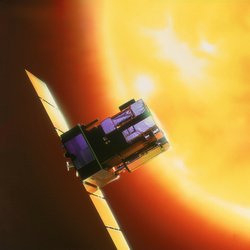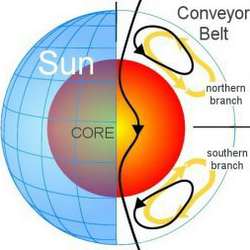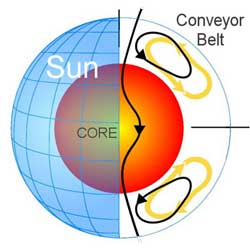NASA’s Swift satellite has spotted one of the most powerful stellar flares ever seen. Fortunately, this killer blast happened on a star located about 135 light-years from Earth. Had the flare occurred on the Sun, it would have triggered a mass extinction on our planet. The flaring star, II Pegasi, has a stellar companion in a very tight orbit. Their interaction has caused the tidally locked stars to spin very quickly. It’s this rapid rotation that leads to powerful stellar flares.
Continue reading “Killer Solar Flare… on Another Star”
First Light Looks Bright for Hinode
Japan’s newly-launched Hinode spacecraft has captured its first images of the Sun. Formerly known as Solar-B, the spacecraft launched on September 22, and opened its instruments to space on October 23, 2006. This image shows granules on the Sun’s surface, each of which is thousands of kilometres across. Over the course of the next month, mission controllers will continue to put the spacecraft through its paces. They expect to release their first scientific data in December.
Continue reading “First Light Looks Bright for Hinode”
Successful Liftoff for NASA’s STEREO Spacecraft
NASA’s solar-observing STEREO spacecraft were carried into space Wednesday evening, atop a Boeing Delta II rocket. STEREO, aka the Solar Terrestrial Relations Observatories, are two nearly identical observatories that will help construct 3-dimensional views of the Sun and its stormy environment. Over the next few months, the spacecraft will perform a series of maneuvers so that one travels ahead of the Earth in orbit, and another trails behind the planet. This will give a view of the Sun from two different vantage points.
Continue reading “Successful Liftoff for NASA’s STEREO Spacecraft”
Solar B Prepares for Launch
Solar flares are the most powerful explosions in the Solar System, releasing enormous energy in the form of radiation, high energy particles and magnetic fields. A new spacecraft, Solar B, developed by the Japanese Space Agency (JAXA) is set to launch on September 22, 2006, and will be able to detect these flares as they’re forming. The spacecraft will measure the movement of magnetic fields across the surface of the Sun, to help scientists predict when they will build up to a flare.
Continue reading “Solar B Prepares for Launch”
STEREO Spacecraft Set for Launch
Get set to see the Sun… in thrilling 3-D! At the end of August, NASA will launch its twin STEREO spacecraft into orbit around the Sun, to provide the first stereoscopic views of coronal mass ejections. The spacecraft will be lofted into space on Thursday, August 31, to begin a 2-year mission; one spacecraft will fly ahead of the Earth in its orbit, and the other will tail back. With this 3-D view, scientists will be able to accurately track the direction and speed of coronal mass ejections, providing much better space weather forecast.
Continue reading “STEREO Spacecraft Set for Launch”
A Magnetically Backwards Sunspot
Astronomers have been waiting to see a very special kind of sunspot, and this week, they saw what they were hoping for: it was backward. It only lasted a few hours, but it reveals that the Sun’s next solar cycle could be getting underway. As the Sun moves through its 11-year cycle of solar maximum and minimums, the magnetic orientation of its sunspots reverses. Solar astronomers think that the upcoming Cycle 24 should be one of the stormiest in decades, producing many sunspots and powerful solar storms. The auroras should be beautiful.
Continue reading “A Magnetically Backwards Sunspot”
Sun’s Corona Simulated
A new simulation by NASA and the National Science Foundation accurately predicted what the Sun’s corona should look like during a recent solar eclipse. The corona is a turbulent region around the Sun which is shaped by twisting magnetic fields. Billions of tonnes of plasma are ejected into space as these fields suddenly snap to new configurations. The simulation too 4 days to complete on a supercomputer with 700 processors.
Continue reading “Sun’s Corona Simulated”
SOHO Mission Extended Through 2009

Artist illustration of SOHO and the Sun. Image credit: ESA. Click to enlarge
NASA and ESA’s long-running Solar and Heliospheric Observatory (SOHO) has been given another mission extension, this time until December 2009. The spacecraft was launched on December 2, 1995, and it has been steadily observing the Sun ever since. Over the next two years, five additional spacecraft will join SOHO to observe the Sun. ESA is involved in two of these spacecraft: Solar B, and Proba-2. NASA will launch the STEREO pair of spacecraft, as well as the Solar Dynamics Orbiter in 2008.
New funding, to extend the mission of ESA’s venerable solar watchdog SOHO, will ensure it plays a leading part in the fleet of solar spacecraft scheduled to be launched over the next few years.
Since its launch on 2 December 1995, The Solar and Heliospheric Observatory (SOHO) has provided an unprecedented view of the Sun – and not just the side facing the Earth. Two teams have now developed techniques for using SOHO to recreate the conditions on the far side of the Sun. The new funding will allow its mission to be extended from April 2007 to December 2009.
Despite being over ten years old now, SOHO just keeps on working, monitoring the activity on the Sun and allowing scientists to see inside the Sun by recording the seismic waves that ripple across the surface of our nearest star.
More than 2300 scientists have used data from the solar observatory to forward their research, publishing over 2400 scientific papers in peer-reviewed journals. During the last two years, at least one SOHO paper has been accepted for publication every working day.
“This mission extension will allow SOHO to cement its position as the most important spacecraft in the history of solar physics,” says Bernhard Fleck, SOHO’s project scientist, “There is a lot of valuable work for this spacecraft still to do.”
During the next two years, five new solar spacecraft will join SOHO in orbit. ESA is involved in two of these spacecraft. The Japan Aerospace Exploration Agency (ISAS/JAXA) has built Solar B and will launch it later this year. ESA will supply the use of a ground station at Svalbard, Norway in exchange for access to the data.
Next year, ESA will launch Proba-2, a technology demonstration satellite that carries solar instruments. In particular, it will carry a complementary instrument to SOHO’s EIT camera. Whilst EIT concentrates on the origin and early development of solar eruptions, Proba-2’s camera will be able to track them into space.
NASA plans to launch the STEREO pair of spacecraft later this year, and the Solar Dynamics Orbiter in 2008. Far from making SOHO obsolete, these newer solar satellites embrace it as a crucial member of the team. SOHO will provide a critical third point of view to assist the analysis of STEREO’s observations. Also, SOHO’s coronagraph will remain unique. The instrument is capable of blotting out the glare from the Sun so that the tenuous outer atmosphere of the Sun is visible for study.
“By next year, we will have a fleet of spacecraft studying the Sun,” says Hermann Opgenoorth, Head of Solar System Missions Division at ESA. This will advance the International Living With a Star programme (ILWS), an international collaboration of scientists dedicated to a long-term study of the Sun and its effects on Earth and the other solar system planets.
ILWS will possibly culminate in the launch of the advanced ESA satellite, Solar Orbiter, around 2015. It is designed to travel close to the Sun, to gain a close-up look at the powerful processes at the heart of our Solar System.
Original Source: ESA News Release
Solar Forecasting Decades Out

Solar astronomers are predicting a very low solar cycle 15 years from now, based on recent observations of the Sun. In the last few years, the Sun’s Great Conveyor Belt – which transfers hot plasma around the star – has slowed to half its normal speed. According to simulations, the speed of this conveyor translates into sunspot activity 20 years in the future. Solar Cycle 25, which peaks in the year 2022, should be one of the weakest ever observed.
The Sun’s Great Conveyor Belt has slowed to a record-low crawl, according to research by NASA solar physicist David Hathaway. “It’s off the bottom of the charts,” he says. “This has important repercussions for future solar activity.”
The Great Conveyor Belt is a massive circulating current of fire (hot plasma) within the Sun. It has two branches, north and south, each taking about 40 years to perform one complete circuit. Researchers believe the turning of the belt controls the sunspot cycle, and that’s why the slowdown is important.
“Normally, the conveyor belt moves about 1 meter per second??bf?walking pace,” says Hathaway. “That’s how it has been since the late 19th century.” In recent years, however, the belt has decelerated to 0.75 m/s in the north and 0.35 m/s in the south. “We’ve never seen speeds so low.”
According to theory and observation, the speed of the belt foretells the intensity of sunspot activity ~20 years in the future. A slow belt means lower solar activity; a fast belt means stronger activity. The reasons for this are explained in the Science@NASA story Solar Storm Warning.
“The slowdown we see now means that Solar Cycle 25, peaking around the year 2022, could be one of the weakest in centuries,” says Hathaway.
This is interesting news for astronauts. Solar Cycle 25 is when the Vision for Space Exploration should be in full flower, with men and women back on the Moon preparing to go to Mars. A weak solar cycle means they won’t have to worry so much about solar flares and radiation storms.
On the other hand, they will have to worry more about cosmic rays. Cosmic rays are high-energy particles from deep space; they penetrate metal, plastic, flesh and bone. Astronauts exposed to cosmic rays develop an increased risk of cancer, cataracts and other maladies. Ironically, solar explosions, which produce their own deadly radiation, sweep away the even deadlier cosmic rays. As flares subside, cosmic rays intensify-yin, yang.
Hathaway’s prediction should not be confused with another recent forecast: A team led by physicist Mausumi Dikpata of NCAR has predicted that Cycle 24, peaking in 2011 or 2012, will be intense. Hathaway agrees: “Cycle 24 will be strong. Cycle 25 will be weak. Both of these predictions are based on the observed behavior of the conveyor belt.”
How do you observe a belt that plunges 200,000 km below the surface of the sun?
“We do it using sunspots,” Hathaway explains. Sunspots are magnetic knots that bubble up from the base of the conveyor belt, eventually popping through the surface of the sun. Astronomers have long known that sunspots have a tendency to drift??bf?from mid solar latitudes toward the sun’s equator. According to current thinking, this drift is caused by the motion of the conveyor belt. “By measuring the drift of sunspot groups,” says Hathaway, “we indirectly measure the speed of the belt.”
Using historical sunspot records, Hathaway has succeeded in clocking the conveyor belt as far back as 1890. The numbers are compelling: For more than a century, “the speed of the belt has been a good predictor of future solar activity.”
If the trend holds, Solar Cycle 25 in 2022 could be, like the belt itself, “off the bottom of the charts.”
Original Source: NASA News Release
Next Solar Max Will Be a Big One

Illustration of the “conveyor belt” on the Sun. Image credit: NASA. Click to enlarge.
We’ve now reached the Sun’s solar minimum; there’s not a sunspot anywhere across the surface of our closest star. Give it a few years, though, and it should be anything but quiet. Solar researchers think they understand the long term cycles of solar activity, and they’re predicting that the next Solar Maximum – expected to arrive between 2010 and 2012 – will be the strongest in 50 years.
It’s official: Solar minimum has arrived. Sunspots have all but vanished. Solar flares are nonexistent. The sun is utterly quiet.
Like the quiet before a storm.
This week researchers announced that a storm is coming–the most intense solar maximum in fifty years. The prediction comes from a team led by Mausumi Dikpati of the National Center for Atmospheric Research (NCAR). “The next sunspot cycle will be 30% to 50% stronger than the previous one,” she says. If correct, the years ahead could produce a burst of solar activity second only to the historic Solar Max of 1958.
That was a solar maximum. The Space Age was just beginning: Sputnik was launched in Oct. 1957 and Explorer 1 (the first US satellite) in Jan. 1958. In 1958 you couldn’t tell that a solar storm was underway by looking at the bars on your cell phone; cell phones didn’t exist. Even so, people knew something big was happening when Northern Lights were sighted three times in Mexico. A similar maximum now would be noticed by its effect on cell phones, GPS, weather satellites and many other modern technologies.
Dikpati’s prediction is unprecedented. In nearly-two centuries since the 11-year sunspot cycle was discovered, scientists have struggled to predict the size of future maxima—and failed. Solar maxima can be intense, as in 1958, or barely detectable, as in 1805, obeying no obvious pattern.
The key to the mystery, Dikpati realized years ago, is a conveyor belt on the sun.
We have something similar here on Earth—the Great Ocean Conveyor Belt, popularized in the sci-fi movie The Day After Tomorrow. It is a network of currents that carry water and heat from ocean to ocean–see the diagram below. In the movie, the Conveyor Belt stopped and threw the world’s weather into chaos.
The sun’s conveyor belt is a current, not of water, but of electrically-conducting gas. It flows in a loop from the sun’s equator to the poles and back again. Just as the Great Ocean Conveyor Belt controls weather on Earth, this solar conveyor belt controls weather on the sun. Specifically, it controls the sunspot cycle.
Solar physicist David Hathaway of the National Space Science & Technology Center (NSSTC) explains: “First, remember what sunspots are–tangled knots of magnetism generated by the sun’s inner dynamo. A typical sunspot exists for just a few weeks. Then it decays, leaving behind a ‘corpse’ of weak magnetic fields.”
Enter the conveyor belt.
“The top of the conveyor belt skims the surface of the sun, sweeping up the magnetic fields of old, dead sunspots. The ‘corpses’ are dragged down at the poles to a depth of 200,000 km where the sun’s magnetic dynamo can amplify them. Once the corpses (magnetic knots) are reincarnated (amplified), they become buoyant and float back to the surface.” Presto—new sunspots!
All this happens with massive slowness. “It takes about 40 years for the belt to complete one loop,” says Hathaway. The speed varies “anywhere from a 50-year pace (slow) to a 30-year pace (fast).”
When the belt is turning “fast,” it means that lots of magnetic fields are being swept up, and that a future sunspot cycle is going to be intense. This is a basis for forecasting: “The belt was turning fast in 1986-1996,” says Hathaway. “Old magnetic fields swept up then should re-appear as big sunspots in 2010-2011.”
Like most experts in the field, Hathaway has confidence in the conveyor belt model and agrees with Dikpati that the next solar maximum should be a doozy. But he disagrees with one point. Dikpati’s forecast puts Solar Max at 2012. Hathaway believes it will arrive sooner, in 2010 or 2011.
“History shows that big sunspot cycles ‘ramp up’ faster than small ones,” he says. “I expect to see the first sunspots of the next cycle appear in late 2006 or 2007—and Solar Max to be underway by 2010 or 2011.”
Who’s right? Time will tell. Either way, a storm is coming.
Original Source: Science@NASA
